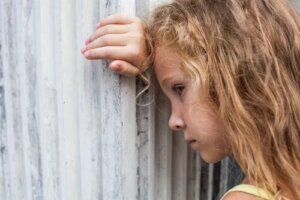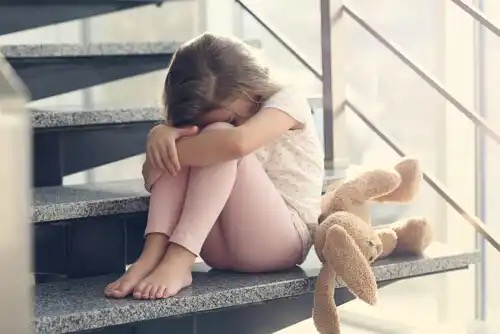Childhood Anxiety Disorders and Treatments

Fear forms part of everyone’s normal development. It’s usually moderately intense and tends to fade over time. However, sometimes, fear reactions in certain children become maladaptive. This can lead to childhood anxiety disorders.
The prevalence of childhood anxiety disorders isn’t inconsiderable. In fact, it’s around eighteen percent. The most frequent disorders are separation anxiety (particularly in children under 12), specific phobias, and generalized anxiety. Childhood anxiety disorders are more common in girls and often present themselves alongside depression.
Anxiety causes symptoms that interfere with a child’s functioning in daily life. These might be within the context of school, family, or social life. The most common physical symptoms are palpitations, headaches, gastric discomfort, nausea, and sleep disturbances.
Anxiety symptoms are often accompanied by worry about different situations. These cause avoidance and escape behaviors. Such behaviors are difficult for parents to manage because they generate negative reinforcements. In fact, parents often give in to the child’s avoidance behavior, thus increasing the problem.

Effective treatments for childhood anxiety
Currently, there are several treatments for childhood anxiety. In fact, the most recommended treatment is psychological therapy. This is because it has no side effects and has proven effective.
However, if psychotherapy doesn’t work well, or the anxiety is too disabling, doctors might offer pharmacotherapy. The preferred drugs are antidepressants. This is because they have less of an effect than anxiolytics on cognitive processes such as memory and learning. In addition, they also might prescribe benzodiazepines. These are useful for reducing anxiety and are used in conjunction with behavioral measures.
Cognitive-behavioral techniques for childhood anxiety
When it comes to cognitive-behavioral treatment, experts recommend multi-component strategies. Here are the most useful:
- Relaxation training for children. This is the treatment of choice for generalized anxiety and separation. It consists of two phases. The first phase demonstrates whether the child has the skills to perform the exercise. They have to be able to stay still for five seconds, maintain eye contact for five seconds, use imitation skills, and follow simple instructions. Once they’ve proved they can do this, the therapist explains to them how anxiety works and teaches them relaxation techniques. These strategies might involve massages, imaginative techniques, and relaxation games. For example, the robot ragdoll game, that consists of the child tensing an area of their body and then completely relaxing it.
- Self-instruction. The child learns to replace cognitive components that cause anxiety with coping statements.
Programs to treat childhood anxiety
- The Coping Cat program by Kendall. This is a cognitive behavioral therapy program that consists of two parts. In the first phase, the child learns to recognize anxiety symptoms and develop a coping plan. This is called the FEAR plan. Also, parents are taught to reinforce coping behaviors and not to complain or criticize. In the second phase, children put these learned skills into action through imagined and live exposure to feared situations.
- The Coping Koala program by Barret et al. This program is similar to the previous one. It also includes a book entitled Family Anxiety Management.
- The FRIENDS program by Barret. This is cognitive behavioral therapy for family-based childhood anxiety problems. There are two versions. One is for children aged six to 11. The other is for children aged 12 to 16. Each initial of the program stands for a technique. For example, the F of FRIENDS stands for feelings (empathy training and self-regulation).
- The FORTIUS program. This is a therapy aimed at children between ages eight to 12. The goal is to develop psychological strength and prevent emotional difficulties. It’s based on the Olympic motto “Citius, Altius, Fortius” (faster, higher, stronger). Children learn how to deal with difficult situations and control negative emotions, especially anxiety. This program has been successfully applied in school and clinical contexts.

Conclusion
Psychological treatments have been very effective in addressing anxiety in children and teens. However, the most relevant element in this area is prevention. This is because children are under an incredible amount of stress. Family ups and downs, unavailable parents, schoolwork, and after-school activities are just some of the factors that might cause anxiety in a child.
For this reason, it’s imperative for parents to lower any unrealistic expectations. They should only set simple and realistic demands.
A decrease in parental expectations and an establishment of reasonable boundaries provides security for a child. In addition, parents should spend quality time with them. Playing with them, caring for them, and listening to them are essential. As a matter of fact, parents should set aside their cell phones, work worries, and disagreements with their partners whenever their children are around.
Fear forms part of everyone’s normal development. It’s usually moderately intense and tends to fade over time. However, sometimes, fear reactions in certain children become maladaptive. This can lead to childhood anxiety disorders.
The prevalence of childhood anxiety disorders isn’t inconsiderable. In fact, it’s around eighteen percent. The most frequent disorders are separation anxiety (particularly in children under 12), specific phobias, and generalized anxiety. Childhood anxiety disorders are more common in girls and often present themselves alongside depression.
Anxiety causes symptoms that interfere with a child’s functioning in daily life. These might be within the context of school, family, or social life. The most common physical symptoms are palpitations, headaches, gastric discomfort, nausea, and sleep disturbances.
Anxiety symptoms are often accompanied by worry about different situations. These cause avoidance and escape behaviors. Such behaviors are difficult for parents to manage because they generate negative reinforcements. In fact, parents often give in to the child’s avoidance behavior, thus increasing the problem.

Effective treatments for childhood anxiety
Currently, there are several treatments for childhood anxiety. In fact, the most recommended treatment is psychological therapy. This is because it has no side effects and has proven effective.
However, if psychotherapy doesn’t work well, or the anxiety is too disabling, doctors might offer pharmacotherapy. The preferred drugs are antidepressants. This is because they have less of an effect than anxiolytics on cognitive processes such as memory and learning. In addition, they also might prescribe benzodiazepines. These are useful for reducing anxiety and are used in conjunction with behavioral measures.
Cognitive-behavioral techniques for childhood anxiety
When it comes to cognitive-behavioral treatment, experts recommend multi-component strategies. Here are the most useful:
- Relaxation training for children. This is the treatment of choice for generalized anxiety and separation. It consists of two phases. The first phase demonstrates whether the child has the skills to perform the exercise. They have to be able to stay still for five seconds, maintain eye contact for five seconds, use imitation skills, and follow simple instructions. Once they’ve proved they can do this, the therapist explains to them how anxiety works and teaches them relaxation techniques. These strategies might involve massages, imaginative techniques, and relaxation games. For example, the robot ragdoll game, that consists of the child tensing an area of their body and then completely relaxing it.
- Self-instruction. The child learns to replace cognitive components that cause anxiety with coping statements.
Programs to treat childhood anxiety
- The Coping Cat program by Kendall. This is a cognitive behavioral therapy program that consists of two parts. In the first phase, the child learns to recognize anxiety symptoms and develop a coping plan. This is called the FEAR plan. Also, parents are taught to reinforce coping behaviors and not to complain or criticize. In the second phase, children put these learned skills into action through imagined and live exposure to feared situations.
- The Coping Koala program by Barret et al. This program is similar to the previous one. It also includes a book entitled Family Anxiety Management.
- The FRIENDS program by Barret. This is cognitive behavioral therapy for family-based childhood anxiety problems. There are two versions. One is for children aged six to 11. The other is for children aged 12 to 16. Each initial of the program stands for a technique. For example, the F of FRIENDS stands for feelings (empathy training and self-regulation).
- The FORTIUS program. This is a therapy aimed at children between ages eight to 12. The goal is to develop psychological strength and prevent emotional difficulties. It’s based on the Olympic motto “Citius, Altius, Fortius” (faster, higher, stronger). Children learn how to deal with difficult situations and control negative emotions, especially anxiety. This program has been successfully applied in school and clinical contexts.

Conclusion
Psychological treatments have been very effective in addressing anxiety in children and teens. However, the most relevant element in this area is prevention. This is because children are under an incredible amount of stress. Family ups and downs, unavailable parents, schoolwork, and after-school activities are just some of the factors that might cause anxiety in a child.
For this reason, it’s imperative for parents to lower any unrealistic expectations. They should only set simple and realistic demands.
A decrease in parental expectations and an establishment of reasonable boundaries provides security for a child. In addition, parents should spend quality time with them. Playing with them, caring for them, and listening to them are essential. As a matter of fact, parents should set aside their cell phones, work worries, and disagreements with their partners whenever their children are around.
All cited sources were thoroughly reviewed by our team to ensure their quality, reliability, currency, and validity. The bibliography of this article was considered reliable and of academic or scientific accuracy.
- American Psychiatric Association (APA) (2014): Manual de Diagnóstico y Estadísitico de los Trastornos Mentales, DSM5. Editorial Médica Panamericana. Madrid.
- Comeche, M y Vallejo, P, M (2016). Manual de Terapia de Conducta en la infancia. 3º edición. Editorial: Dykinson-Psicología
This text is provided for informational purposes only and does not replace consultation with a professional. If in doubt, consult your specialist.







